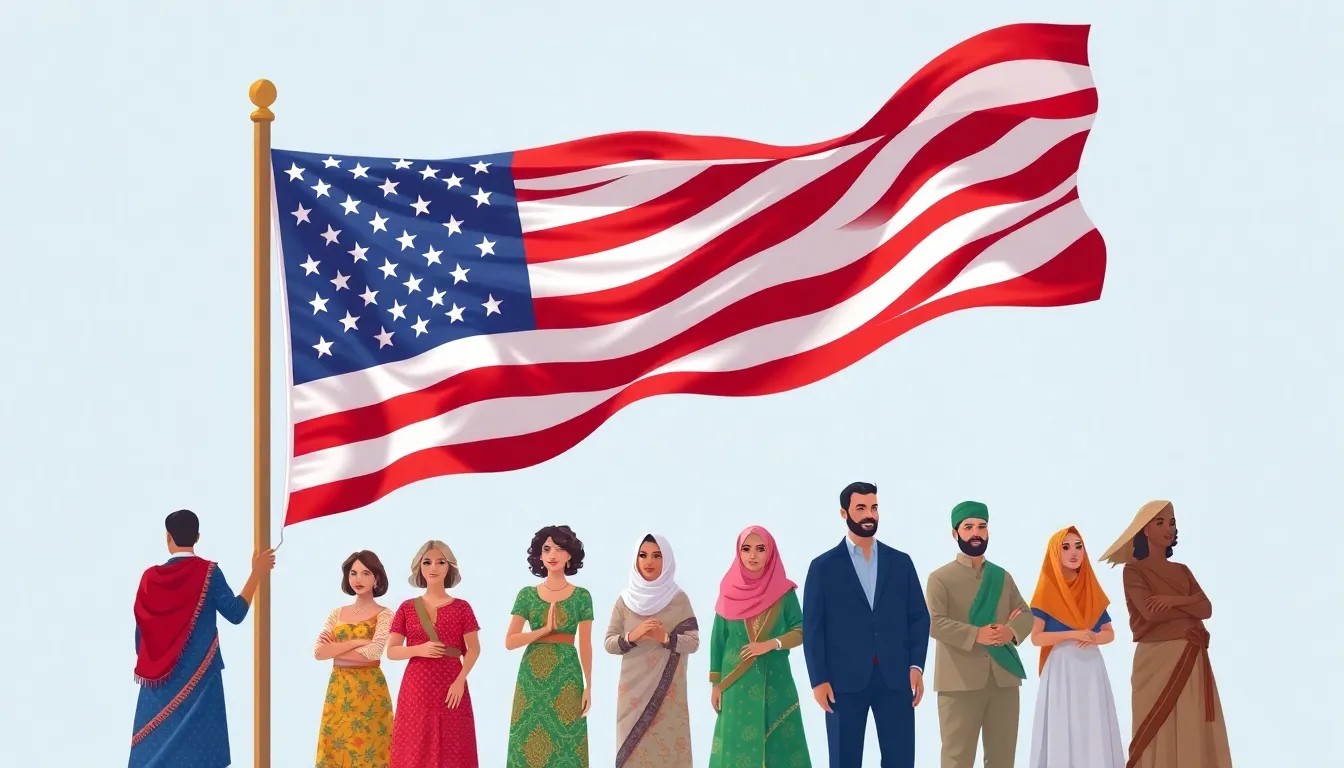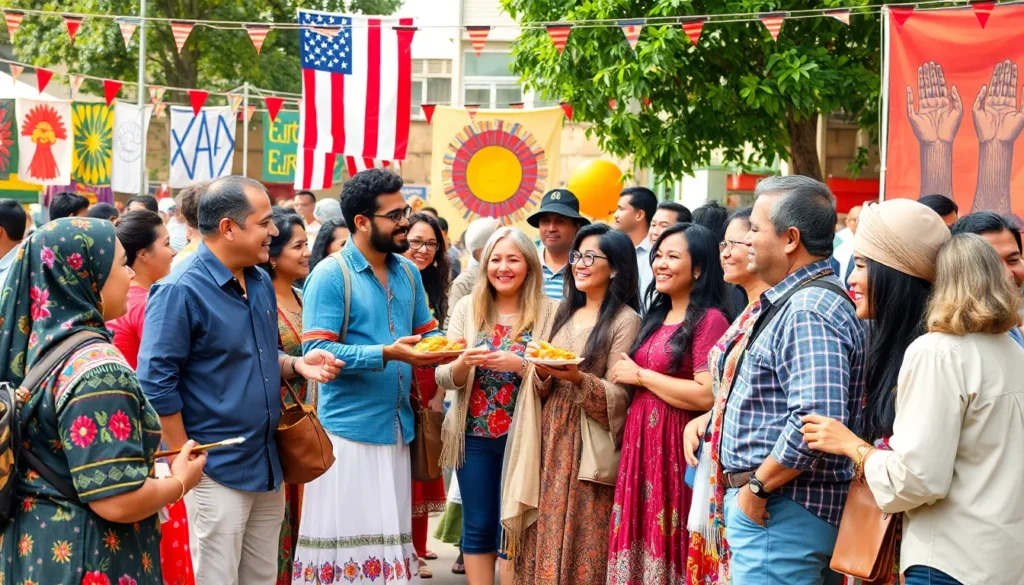Culture shapes the way people live, think, and interact. It’s like the invisible glue that holds societies together, influencing everything from food preferences to fashion choices. But what exactly makes up this fascinating tapestry?
Table of Contents
ToggleComponents of Culture
Culture consists of several crucial components that collectively shape societies. Language serves as a primary means of communication, influencing how people express their thoughts and emotions. Norms establish expected behaviors within a community, guiding social interaction and relationship building.
Values reflect the core beliefs of a society, dictating what is considered important or worthwhile. These values influence actions, decisions, and even laws within the culture. Symbols, like flags or religious icons, carry specific meanings and evoke strong emotional responses.
Rituals hold special significance in various cultures, often marking important life events such as births, marriages, and deaths. Food customs also play a vital role in cultural identity, as culinary practices differ across regions and serve as a source of pride.
Artistic expression in the form of music, dance, and visual arts serves to reflect and reinforce cultural themes. Additionally, clothing styles showcase cultural heritage and individuality, often representing social status or group identity.
Technology impacts culture by transforming communication, transportation, and daily life. Its constant evolution continues to shape interactions and influence cultural exchange. Education provides knowledge and skills necessary for societal participation, molding future generations to align with cultural values.
By understanding these components, individuals can appreciate the rich tapestry of culture that binds communities and enhances personal identities.
Symbols

Symbols play a crucial role in conveying deeper meanings within cultures. They represent ideas, beliefs, and values, often evoking strong emotional connections.
Importance of Symbols in Culture
Symbols act as significant identifiers within a culture. They help reinforce group identity and convey complex messages succinctly. Communities use symbols to express shared values and histories. These representations foster unity among members, bridging differences in language or customs. Their impact extends beyond the individual, influencing social dynamics and relationships.
Examples of Cultural Symbols
Cultural symbols manifest in various forms. The flag serves as a powerful national symbol, representing unity and identity. Religious symbols, such as the cross in Christianity or the crescent in Islam, convey spiritual significance. Other examples include traditional attire like the kimono in Japan or the sombrero in Mexico, which highlight cultural heritage. Artifacts, such as totem poles among Indigenous cultures, tell stories and preserve history. Such symbols enrich cultural identities and provide meaningful connections.
Language
Language serves as a fundamental component of culture, shaping interactions and expressing identity. It reflects shared values and beliefs, enabling individuals to connect within their communities.
Role of Language in Cultural Identity
Language defines cultural identity by allowing individuals to communicate thoughts, traditions, and emotions. Shared languages foster strong bonds among community members, providing a sense of belonging. Dialects and accents often reveal regional identities, highlighting the diversity within larger cultural frameworks. Each language carries unique expressions and idioms, reinforcing cultural heritage while allowing for personal storytelling. Language preservation plays an essential role in safeguarding cultural history, connecting generations while imparting wisdom.
Language and Communication Styles
Communication styles vary significantly across cultures, impacting interactions. Some cultures prefer direct communication, valuing clarity and efficiency. Others may embrace indirect styles, emphasizing context and nonverbal cues. Tone and body language often modify the message, adding layers of meaning that differ from culture to culture. Gaining insight into these varying styles enhances understanding and promotes effective dialogue. Cross-cultural awareness becomes vital in global interactions, as differences can lead to misinterpretation if not recognized.
Norms and Values
Norms and values form the backbone of cultural identity. They guide behavior and establish societal expectations.
Types of Norms in Society
Norms manifest in various forms within a society. Folkways govern everyday behavior, such as dress codes and dining etiquette. Mores represent moral standards, influencing laws against theft or violence. Taboos, on the other hand, are prohibitive norms, like those surrounding cannibalism or incest, evoking strong reactions when violated. Each type plays a crucial role in maintaining social order and cohesion.
Core Values of Different Cultures
Core values shape how societies perceive right and wrong. Individualism, for instance, emphasizes personal freedom and self-reliance in Western cultures. Collectivism prioritizes group harmony and community well-being in many Asian cultures. Other values, such as respect for elders in Indigenous cultures, highlight cultural priorities unique to those societies. A clear understanding of these values fosters respect and appreciation for diverse cultural perspectives.
Traditions and Customs
Traditions and customs serve as vital components of culture, shaping identities and fostering community bonds.
Rituals and Ceremonies
Rituals and ceremonies mark significant life events and cultural expressions. Celebrations like weddings and funerals differ across cultures, showcasing unique practices. For instance, some communities may perform elaborate rites to honor ancestors, while others focus on communal gatherings. Rituals strengthen social ties and offer participants a sense of belonging and identity. They often include specific behaviors, symbols, and attire that carry deep meaning. Shared experiences during rituals foster connections among individuals, uniting them in common heritage and beliefs.
Influence of Customs on Daily Life
Customs significantly impact daily life, influencing behaviors and interactions. Daily practices such as greetings, meal sharing, and social etiquette reflect cultural values. For example, cultures emphasizing collectivism may prioritize group meals and family gatherings, reinforcing unity. Customs can dictate routines, from how people celebrate holidays to everyday norms in public spaces. Additionally, individuals adapt their behaviors based on cultural expectations, ensuring harmony within communities. The presence of distinct customs enriches social interactions and perpetuates cultural adherence across generations.
Understanding the components of culture is essential for appreciating the diversity that shapes human experiences. Each element—from language to rituals—plays a vital role in defining identities and fostering connections within communities. By recognizing how norms, values, and symbols influence behavior and interactions, individuals can navigate cultural landscapes more effectively.
As societies continue to evolve, the interplay of these cultural components will remain crucial in shaping future generations. Embracing this complexity enriches personal experiences and promotes harmony in an increasingly interconnected world.




